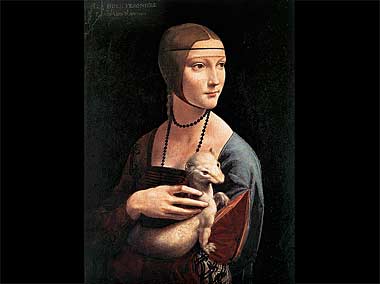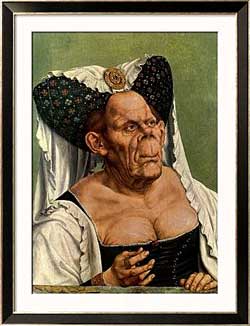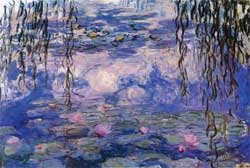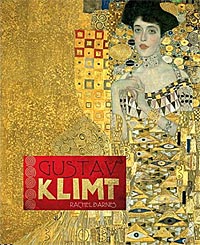3D Art
3D computer graphics (in contrast to 2D computer graphics) are graphics that use a three-dimensional representation of geometric data (often Cartesian) that is stored in the computer for the purposes of performing calculations and rendering 2D images. Such images may be stored for viewing later or displayed in real-time.
read more...
Abstract Expressionism
Movement in painting, originating in New York City in the 1940s. It emphasized spontaneous personal expression, freedom from accepted artistic values, surface qualities of paint, and the act of painting itself. Pollock, de Kooning, Motherwell, and Kline, are important abstract expressionists.
read more...
Action Art / Action Painting
Connected to the Abstract Expressionist movement, but more precise in its meaning, Action Painting believes in the expressive power held in the actual act of painting as much as in the finished product. Rosenberg defined the notion of the canvas as seen by the artists in this movement as being 'not a picture but an event'.
read more...
to the top
Art Deco
Design style prevalent during the 1920s and 1930s, characterized by a sleek use of straight lines and slender form.
read more...
Art Nouveau
A decorative art movement that emerged in the late nineteenth century. Characterized by dense asymmetrical ornamentation in sinuous forms, it is often symbolic and of an erotic nature. Klimt worked in an art nouveau style.
read more...
Ash Can School
Group of American artists active from 1908 to 1918. It included members of The Eight such as Henri and Davies; Hopper was also part of the Ash Can group. Their work featured scenes of urban realism.
read more...
Barbizon School
An association of French landscape painters, c. 1840-70, who lived in the village of Barbizon and who painted directly from nature. Theodore Rousseau was a leader; Corot and Millet were also associated with the group.
read more...
Baroque
A movement in European painting in the seventeenth and early eighteenth centuries, characterized by violent movement, strong emotion, and dramatic lighting and coloring. Bernini, Caravaggio and Rubens were among important baroque artists.
read more...
to the top Bauhaus
A school of art, design and architecture founded in Germany in 1919. Bauhaus style is characterized by its severely economic, geometric design and by its respect for materials. The Bauhaus school was created when Walter Gropius.
read more...
Bloomsbury Group
The Bloomsbury group was basically a group of like minded friends with a 'common attitude to life', many of whom had first met at Trinity College, Cambridge at the turn of the century.The group included Clive Bell, John Maynard Keynes, Desmond McCarthy, Leonard Woolf and Saxon Sydney Turner.
read more...
to the top
Byzantine
A style of the Byzantine Empire and its provinces, c. 330-1450. Appearing mostly in religious mosaics, manuscript illuminations, and panel paintings, it is characterized by rigid, monumental, stylized forms with gold backgrounds.
read more...
Classicism
Referring to the principles of Greek and Roman art of antiquity with the emphasis on harmony, proportion, balance, and simplicity. In a general sense, it refers to art based on accepted standards of beauty.
read more...
Color field painting
A technique in abstract painting developed in the 1950s. It focuses on the lyrical effects of large areas of color, often poured or stained onto the canvas. Newman, Rothko, and Frankenthaler painted in this manner.
read more...
Conceptual Art
A movement of the 1960s and 1970s that emphasized the artistic idea over the art object. It attempted to free art from the confines of the gallery and the pedestal.
read more...
to the top
Constructivism
A Russian abstract movement founded by Tatlin, Gabo, and Antoine Pevsner, c. 1915. It focused on art for the industrial age. Tatlin believed in art with a utilitarian purpose.
read more...
Cubism
A revolutionary movement begun by Picasso and Braque in the early twentieth century. It employs an analytic vision based on fragmentation and multiple viewpoints.
read more...
Empire Style
The Empire Style, sometimes considered the second phase of Neoclassicism, is an early-19th-century design movement in architecture, furniture, other decorative arts, and the visual arts.
read more...
Dadaism
A movement, c. 1915-23, that rejected accepted aesthetic standards. It aimed to create antiart and nonart, often employing a sense of the absurd.
read more...
Der Blauer Reiter
The name derived from a drawing by Wassily Kandinsky that appeared on the cover of the Almanac featuring a blue horseman. Established in December 1911 by Kandinsky, Marc and Gabriele Munter their first show was entitled 'First Exhibition by the Editorial Board of the Blue Rider' and was launched to coincide with the last show by the NKV in the same gallery in Munich.
read more...
Die Neue Sachlichkeit (The New Objectivity) was an Expressionist movement founded in Germany in the aftermath of World War I by George Grosz and Otto Dix. Its artwork is characterized by a realistic style combined with a cynical and socially critical philosophical stance. Other artists associated with the movement included Christian Schad and Max Beckmann.
read more...
to the top
Digital Art
3D computer graphics (in contrast to 2D computer graphics) are graphics that use a three-dimensional representation of geometric data (often Cartesian) that is stored in the computer for the purposes of performing calculations and rendering 2D images. Such images may be stored for viewing later or displayed in real-time.
read more...
The Eight
A group of American painters who united out of opposition to academic standards in the early twentieth century. Members of the group were Robert Henri, Arthur Davies, Maurice Prendergast, William James Glackens, Ernest Lawson, Everett Shinn, John Sloan, and George Luks.
read more...
Expressionism
Refers to art that uses emphasis and distortion to communicate emotion. More specifically, it refers to early twentieth century northern European art, especially in Germany c. 1905-25. Artists such as Rouault, Kokoschka, and Schiele painted in this manner.
read more...
Fauvism
From the French word fauve , meaning "wild beast ." A style adopted by artists associated with Matisse, c. 1905-08. They painted in a spontaneous manner, using bold colors.
read more...
to the top
Flemish School
Characterised by idealism and experimentation with perspective, Flemish Art thrived in the 15th century with artists such as Jan van Eyck, Rogier van der Weyden, Hans Memling and Dirk Bouts. They specialised in portrait painting with religious themes and complicated iconography.
read more...
Fluxus
The movement encompassed a new aesthetic, a reductive gesturality, part Dada, part Bauhaus and part Zen, and presumes that all media and all artistic disciplines are fair game for combination and fusion. Fluxus presaged avant-garde developments over the last 40 years. Fluxus objects and performances are characterized by minimalist but often expansive gestures based in scientific, philosophical, sociological, or other extra-artistic ideas and leavened with burlesque.
read more...
Folk art
Works of a culturally homogeneous people without formal training, generally according to regional traditions and involving crafts.
read more...
Futurism
An Italian movement c. 1909-19. It attempted to integrate the dynamism of the machine age into art. Boccioni was a futurist artist.
read more...
to the top
Gothic
A European movement beginning in France. Gothic sculpture emerged c. 1200, Gothic painting later in the thirteenth century. The artworks are characterized by a linear, graceful, elegant style more naturalistic than that which had existed previously in Europe.
read more...
Graffiti Art
This was a movement which achieved an enormous amount of success in New York in the 1980s. It was named after the spray-can vandalism common in most cities and most associated with the New York subway system.
The two most successful figures of this movement were Jean-Michel Basquiat and Keith Haring. The New York art scene embraced Graffiti Art, with several galleries specialising in the genre and a Museum of American Graffiti opening in 1989.
read more...
to the top
Group of Seven
The Group of Seven Artists began in the early 1900s when several Canadian Artists began noticing a similarity in style. Canadian Painters Tom Thomson, J.E.H. MacDonald, Arthur Lismer, Frederick Varley, Frank Johnston and Franklin Carmichael were often believed to have socialised together through common interests and mutual employment.
read more...
Harlem Renaissance
From 1920 until about 1930 African-American cultural movement became known as "The New Negro Movement" and later as the Harlem Renaissance. More than a literary movement and more than a social revolt against racism, the Harlem Renaissance exalted the unique culture of African-Americans and redefined African-American expression.
read more...
Impressionism
A late-nineteenth-century French school of painting. It focused on transitory visual impressions, often painted directly from nature, with an emphasis on the changing effects of light and color. Monet, Renoir, and Pissarro were important impressionists.
read more...
to the top
Kitsch
Kitsch is the German and Yiddish word denoting art that is considered an inferior, tasteless copy of an extant style of art.
read more...
Mannerism
A style, c. 1520-1600, that arose in reaction to the harmony and proportion of the High Renaissance. It featured elongated, contorted poses, crowded canvases, and harsh lighting and coloring.
read more...
Massurrealism
Stands for a fusion of the dream like visions of surrealism, pop art and New Media Technology - as well as for an expression of the Hyper-real.
read more...
Minimalism
A movement in American painting and sculpture that originated in the late 1950s. It emphasized pure, reduced forms and strict, systematic compositions.
read more...
Nabis
From the Hebrew word for "prophet." A group of French painters active in the 1890s who worked in a subjective, sometimes mystical style, stressing flat areas of color and pattern. Bonnard and Vuillard were members.
read more...
to the top
Naive Art
Artwork, usually paintings, characterized by a simplified style, nonscientific perspective, and bold colors. The artists are generally not professionally trained. Henri Rousseau and Grandma Moses worked in this style.
read more...
Neoclassicism
A European style of the late eighteenth and early nineteenth centuries. Its elegant, balanced works revived the order and harmony of ancient Greek and Roman art. David and Canova are examples of neoclassicists.
read more...
Op Art
An abstract movement in Europe and the United States, begun in the mid-1950s, based on the effects of optical patterns. Albers worked in this style.
read more...
to the top
Photorealism
A figurative movement that emerged in the United States and Britain in the late 1960s and 1970s. The subject matter, usually everyday scenes, is portrayed in an extremely detailed, exacting style. It is also called superrealism, especially when referring to sculpture.
read more...
Pointilism
A method of painting developed by Seurat and Paul Signac in the 1880s. It used dabs of pure color that were intended to mix in the eyes of viewers rather than on the canvas. It is also called divisionism or neoimpressionism.
read more...
Pop Art
A movement that began in Britain and the United States in the 1950s. It used the images and techniques of mass media, advertising, and popular culture, often in an ironic way. Works of Warhol, Lichtenstein, and Oldenburg exemplify this style.
read more...
Postimpressionism
A term coined by British art critic Roger Fry to refer to a group of nineteenth-century painters, including Cezanne, Van Gogh, and Gauguin, who were dissatisfied with the limitations of expressionism. It has since been used to refer to various reactions against impressionism, such as fauvism nd expressionism.
read more...
to the top
Pre-Raphaelite Brotherhood
A group of English painters formed in 1848. These artists attempted to recapture the style of painting preceding Raphael. They rejected industrialized England and focused on painting from nature, producing detailed, colorful works. Rossetti was a founding member.
read more...
Realism
In a general sense, refers to objective representation. More specifically, a nineteenth century movement, especially in France, that rejected idealized academic styles in favor of everyday subjects. Daumier, Millet, and Courbet were realists.
read more...
Renaissance
Meaning "rebirth" in French. Refers to Europe c. 1400-1600. Renaissance art which began in Italy, stressed the forms of classical antiquity, a realistic representation of space based on scientific perspective, and secular subjects. The works of Leonardo, Michelangelo, and Raphael exemplify the balance and harmony of the High Renaissance (c. 1495-1520).
read more...
to the top
Rococo
An eighteenth-century European style, originating in France. In reaction to the grandeur and massiveness of the baroque, rococo employed refined, elegant, highly decorative forms. Fragonard worked in this style.
read more...
Romanesque
A European style developed in France in the late eleventh century. Its sculpture is ornamental, stylized and complex. Some Romanesque frescoes survive, painted in a monumental, active manner.
read more...
Romanticism
A European movement of the late eighteenth to mid nineteenth century. In reaction to neoclassicism, it focused on emotion over reason, and on spontaneous expression. The subject matter was invested with drama and usually painted energetically in brilliant colors. Delacroix, Gericault, Turner, and Blake were Romantic artists.
read more...
to the top
Situationism
Influenced by Dada, Surrealism and Lettrism. The post-war Lettrist International, which sought to fuse poetry and music and transform the urban landscape, was a direct forerunner of the group who founded the magazine 'Situationiste Internationale' in 1957. At first, they were principally concerned with the "suppression of art", that is to say, they wished like the Dadaists and the Surrealists before them to supersede the categorization of art and culture as separate activities and to transform them into part of everyday life.
read more...
De STIJL
An art movement advocating pure abstraction and simplicity-- form reduced to the rectangle and other geometric shapes, and colour to the primary colours, along with black and white. Piet Mondrian was the group's leading figure. He published a manifesto titled Neo-Plasticism in 1920. Another member, painter Theo van Doesberg had started a journal named De Stijl, spreading the theories of the group. Their work exerted tremendous influence on the Bauhaus and the International Style.
read more...
to the top
Suprematism
A Russian abstract movement originated by Malevich c. 1913. It was characterized by flat geometric shapes on plain backgrounds and emphasized the spiritual qualities of pure form.
read more...
Surrealism
A movement of the 1920s and 1930s that began in France. It explored the unconscious, often using images from dreams. It used spontaneous techniques and featured unexpected juxtapositions of objects. Magritte, Dali, Miro, and Ernst painted surrealist works.
read more...
Symbolism
A painting movement that flourished in France in the 1880s and 1890s in which subject matter was suggested rather than directly presented. It featured decorative, stylized, and evocative images.
read more...
to the top |





